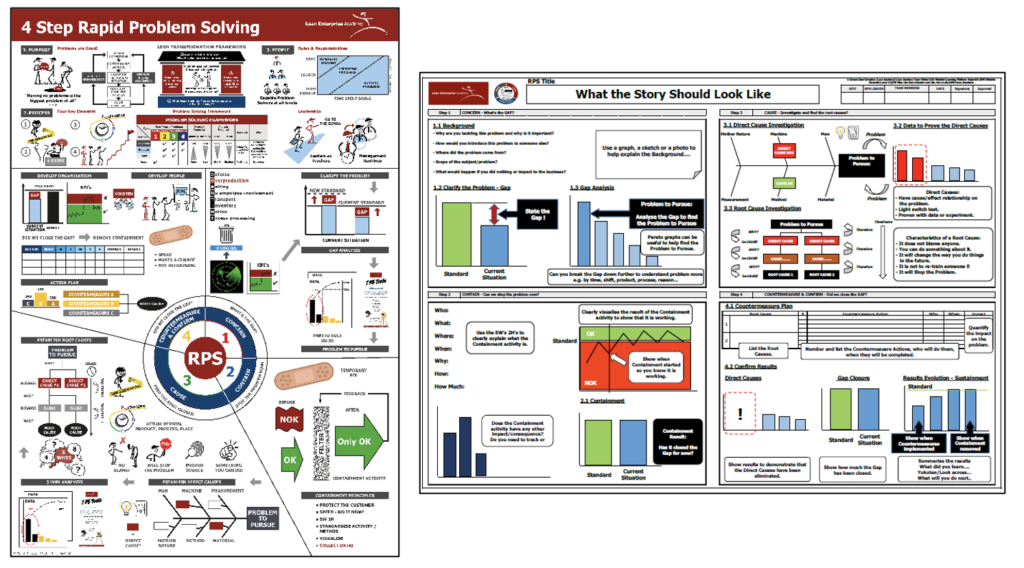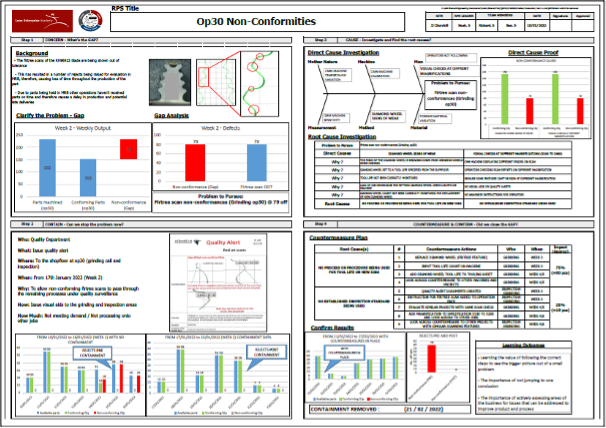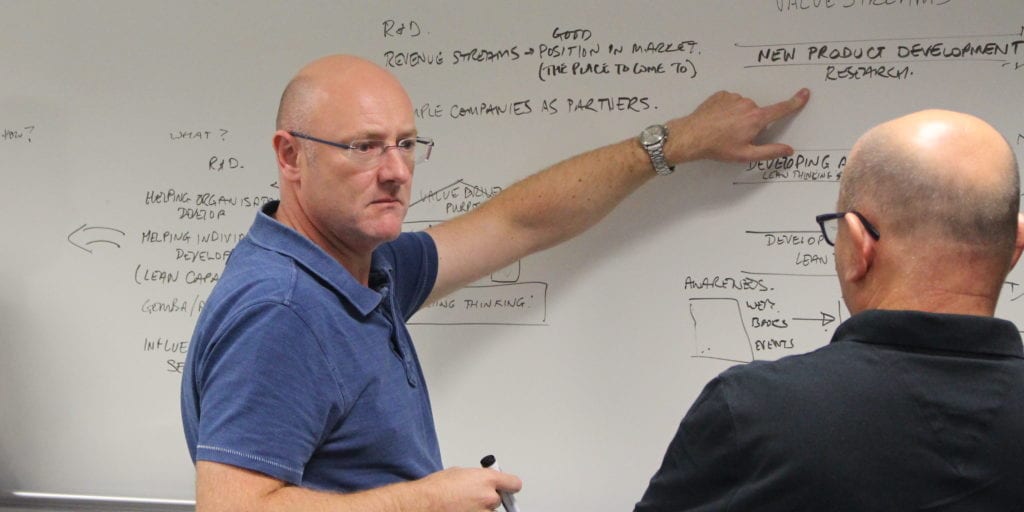Lean Learning, Reinvented
May 6, 2022

INTERVIEW – From hospitals to start-ups, lean principles have been applied far beyond their origins at Toyota. This article discusses how lean can be applied to learning – specifically, how we can apply lean learning to learning lean.
Words: David Marriott, Dave Brunt and Sarah Gregory
Learning is a topic in its own right. Peter Senge’s seminal book The Fifth Discipline argued the need for the learning organisation. At the Lean Enterprise Academy, we have researched how companies best learn lean for 30 years. We even ran a whole Lean Summit on the topic back in 2016, titled Lean Learning, Learning Lean. Our conclusion then, as now, is that many providers of lean training, development and capability building are out of step with what is needed. Furthermore, customers and potential customers frequently place too much emphasis on qualifications and accreditation (such as certifications and belts) rather than learning through solving real problems.
LEAN LEARNING
To understand what lean learning is, it helps to articulate what lean is. At LEA, we define lean as “providing the most value from the customers’ perspective, while consuming the fewest resources and utilising the talents of the people who do the work.” On their global website, Toyota explains that its production system (known as Toyota Production System) is “based on the philosophy of achieving the complete elimination of all waste in pursuit of the most efficient methods.” TPS has two pillars: Jidoka and Just-in-Time. The former is about creating a system (process and people) with the ability to detect when an abnormal condition occurs and immediately stop work. The latter focuses on making “only what is needed, when it is needed, and in the amount needed.”
But how do we apply Jidoka and Just-in-Time to learning? Applying lean to learning means creating learning processes for people that have the ability to detect an abnormal condition and immediately stop work, building quality into the learning process and into the pupil. Learning “just-in-time” means learning what is needed, when needed, and in the amount needed. Additionally, for learning to be lean, ongoing kaizen (continuous improvement) must be applied – to steadily simplify the learning process.
HOW TO KAIZEN YOUR LEARNING PROCESSES
Steve Glaveski argued the need for lean learning in his 2019 HBR article “Where companies go wrong with Learning and Development.” Glaveski wrote that we are learning:
- For the wrong reasons
- At the wrong time
- The wrong things
And
- We quickly forget what we have learned
At the Lean Enterprise Academy, we have identified each of these failure modes and a number of gaps in learning performance. To close those gaps, we took one lean subject area – problem solving – and designed a number of experiments to see if we can improve capability transfer and development. We chose problem solving because it is a skill we see as a fundamental requirement to any organisation or individual on a lean journey. Here we describe one such experiment, the outcomes and our learning through a Q&A session with Planet Lean’s editor Roberto Priolo.
Roberto Priolo: Sarah, tell me about JJ Churchill.
Sarah Gregory: JJ Churchill is a specialist engineering company with over 80 years of experience, demonstrating expertise in new product development, volume manufacture, and spare part production. The company is a Tier 1 supplier to the aerospace, power generation, diesel, defence, nuclear and med-tech industries. JJ Churchill works with advanced materials, geometries, and technologies. We enlist the work of talented engineers to produce parts with superlative repeatability. The headquarters, which are based in the town of Market Bosworth, UK, sits on 1.6 hectares with the workshops covering 5,000 square meters.

RP: What was the problem to solve and what process was used to solve it?
David Marriott: The organisation wanted to develop problem-solving capability for supervision and apprentice engineers. We agreed to teach our “Rapid problem-solving method” to a cohort of 12 participants.
To both standardize the process and make available learning materials, when needed and in the amount needed, LEA has developed an online learning platform. Structured around the Lean Transformation Framework, the Lean Learning Journey process is based around four skill levels:
- Knowledge.
- Understanding.
- Capable.
- Can Do Well, Teach & Coach Others.
The aim of the process is for the customer (in this case, JJ Churchill) to become capable in the skill chosen and self-reliant, so they can share learning and develop others within their team. Lean learning is a journey. Therefore, the approach we used blends our online learning platform – to get a basic understanding of the concepts – with coaching on real problems. In this case, the process lasted eight weeks, starting in January 2022.
Firstly, people used our online learning platform to get a basic understanding of the concepts (what we refer to as Level 1). A week later, I went back for face-to-face teaching, which I delivered using our teach posters and a case study the participants could practice on. We then divided the group in four teams of three people, who were invited to go out on the gemba and find a problem to solve.
RP: What is a Teach Poster and what are the benefits?
Dave Brunt: For a sustainable lean transformation, we are strong believers in the idea of “leaders as teachers” – that is leaders who take the time to teach and coach their team, on the job, to develop their capabilities rather than relying on separate function(s) to do it for them. As you know, the benefits of doing this are huge in terms of advancing your lean journey better, faster, and cheaper. The challenge is, however, how to provide materials that enable leaders to do that.
After many years of research and experimentation, we have found that the Teach Poster concept works best. Rather than a 100-page PowerPoint slide deck, we have tried to distil the subject matter down onto one piece of paper – a bit like an A3!
The benefits are that the approach is much less daunting for the leaders to use and much more informal than sitting down in a classroom looking at a screen. Posters have a similar layout and structure making them easier to follow and remember. Images/pictures are used over words to stimulate interest and discussion. A facilitation guide is written for each poster covering the “Important Steps”, “Key Points” and “Reasons” for each of the images to assist the leader when starting out to teach. Finally, the poster can be put up in your workspace for future reference rather than being hidden on a computer.
RP: What sort of problems did the teams at JJ Churchill tackle?
DM: Three out of four projects were heavily focused on quality – particularly scrap and defect reduction. Deeper learning occurred in that following analysis participants carried out on the shop floor, when they became aware of the importance of developing robust standards people can refer to. Examples for each of the three quality-related projects include standards on when a machine needs intervention to put it into specification, the level of magnification to be used in inspecting a product, and how to insert a part into a fixture. This latter problem, for instance, was solved with the introduction of a clever poka-yoke (mistake-proofing system) that was shared across the business.
The fourth project related to EDM (electrical discharge machining) and on the operational improvement of the set-up time of one of the machines. When the team studied operators over two shifts, they realized that the set-up was performed by engineers, rather than the operators themselves. The reason was that there were specifications – for instance on what tools to use – but no standard procedure on how to do it and in what timeframe.
Specifications are not enough; you really need to understand the work and the training people receive needs to reflect that. Indeed, across all four problems, it was clear there was a capability issue. The theory was there (extensive training had been provided), but it was often hard for people to put it into practice.

RP: What were the results?
SG: We carried out a management report-out. The teams explained their improvements and learning to the management team. And we were all very impressed.
I can tell you that one of the projects will likely deliver savings in the region of £40k, in terms of product and management time. We have also seen a reduction in our scrap rates. Most importantly, we have seen big gains in terms of customer satisfaction and right-first-time.
As a management team, our big realization was that we need to do even more to train our people and ensure that training leads to capability development. This is now a key deliverable for me.
It’s been great to see how these solving problems has a real impact on the people working at JJ Churchill. To give you an example, an operator running the machine one of the improvements focused on emailed the team responsible for the change, thanking them for making his life easier. It’s this kind of benefit that will ultimately allow our new approach to problem-solving to spread across the company.
RP: What have you done with this since?
SG: All the posters are on display on the shop floor, on our Achievements Board, for everybody to see. This way people will be able to see what improvements were made and we are sure they will be inspired by them. Besides, we think it’s fundamental to celebrate the successes the teams have had.
We have also organized sessions for the groups to tell senior management what they have done since the improvements were made, and whether they have used the same approach to solve other problems. We are currently identifying our next group who will go through the next development session.
RP: Considering participants were younger people who presumably haven’t had much prior exposure to Lean Thinking, it sounds like this approach is a great way to shape a lean thinker from the get-go…
DM: Absolutely. We believe that developing one’s ability to learn is not a “lean thing”, it’s a life skill that people are lucky to work on so early in their careers. In our minds, this should be a much bigger focus in our education system and in our businesses. People at JJ Churchill told us that they did not expect to learn so much, and they were thrilled with the results they could achieve.
RP: Dave, LEA launched its online learning platform in September 2020. What are your reflections 18 months in?
Dave Brunt: We have known for a long time that many companies – especially larger ones –tend to treat lean as a “program”. Participants typically get an introduction to Lean Thinking, play games, maybe do a simulation, but then they don’t know what to do with any of it. This lean-in-a-box promises a lot but often under-delivers. Lean isn’t a project that you can separate from the way you manage and develop your organization.
At LEA, we have a different approach: we want people to realize that learning is a journey (one that they can shape and design), a series of learning processes they can follow that take them to a deeper level of learning and capability each time they practice. The point is not to be certified at the organization or individual level through competency systems or belts, an approach which often misses learning lean as a journey.
Lean learning needs to encompass Jidoka and Just-in-Time. We can’t build quality people if we don’t build quality into our learning processes. Delivering Just-in-Time requires delivering learning in small batches (organized in the four levels – Knowledge; Understanding; Being Capable; Can Do Well, Teach & Coach Others). To develop capability you must practice, with a cadence. When this is done well, you can move from push-based to pull-based learning, which in turn leads to discovery on the part of the learner.
The purpose of the Learning Platform is to provide structure for the learning journey. With it, we wanted to achieve two things: make lean learning accessible for people (both in terms of cost and ease of use) and free up time for everyone – whether that’s the learner, an organization’s managers or lean coaches, or our own coaches.
We (and many of our partners) have very experienced coaches. Understanding how they spend their time and thinking through how best they can create value has led us to develop re-usable learning materials that people can easily use to gain knowledge on their own. This frees up the coach to coach and challenge an organization’s existing thinking – that’s where we can provide the most value, by helping people to put what they learn into practice. Blending great coaching with great material and a platform that allows people to pull learning as they need it is really where we believe we are making a difference.
Internally, we can practice what we preach. We have a standard for learning materials which we apply kaizen to. We also have a standard for the learning process, which can be configured to meet an individual customer’s needs.
Before we introduced the platform, we wouldn’t have been able to support JJ Churchill as effectively (in terms of quality, delivery, and cost) as we did. We believe that our teaching material and a defined learning process move organizations beyond “projects”, in terms of both capability development and business benefits.
DM: Dave raises an important point. I suspect that the reason why many organizations don’t get the results they expect from lean is that their approach to capability development is lacking and too focused on theory. Classroom learning is great, but my experience as a coach taught me that people really learn to identify and close a gap when they are asked to apply the theory to a concrete, real-life problem. And that’s where my efforts as a coach focused on at JJ Churchill.
RP: Sarah, in your mind, how does this approach LEA uses compare to previous lean training you have experienced in the past?
Sarah: I first got involved in kaizen in the early 1990s and I have seen my fair share of lean initiatives over the years. For me, the key benefit of the LEA approach was their absolute focus on helping people get out of “solution mode” and concentrate on proper problem identification. Most approaches I have seen before have you jump to solutions, only to see them not working and being sustained.
Having David Marriott as our coach on site really worked from a facilitation point of view. Not only did he help us to put teachings into practice in real time, which made a huge difference, but he also consistently challenged our way of thinking. That was so refreshing and different!
THE AUTHORS

David Marriott is a Senior Lean Coach at the Lean Enterprise Academy in the UK.

Dave Brunt is CEO of the Lean Enterprise Academy in the UK.

Sarah Gregory is Director of Operations at JJ Churchill.
Original Article: https://planet-lean.com/lean-learning-jj-churchill/
Stay In Touch.
Subscribe to our newsletter and exclusive Leadership content.
We respect your privacy and won’t spam your inbox
